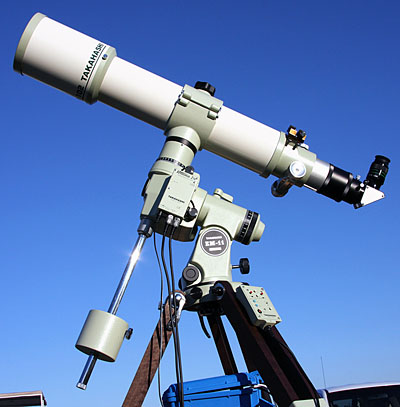 |
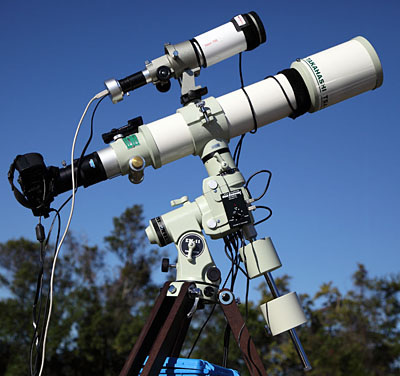 |
The Takahashi EM-11 is rated to carry a 18.75
lb (8.5 kg) telescope system load (The Takahashi America website at
the time of writing this web page lists the mount capacity at 25
lbs.) The TSA-102 with focuser extension, diagonal and clamshell
mount ring weighs about 14 lbs and is balanced on the EM-11 with the
standard 7 lb. (3.5 kg) counter weight. My experience running the
system with TheSky6 Professional was that the mount would move from
object to object during Goto movement and consistently place objects
in the center of a 42 arc minute viewing circle (center of Televue
7mm Nagler 6 eyepiece field).
The TSA-102 is an incredibly
strong performing visual instrument with superb contrast and no
false color when viewing Jupiter. Deep sky objects "pop"
out of the heavens when viewing at a dark sky location. The EM-11
provides solid support for the TSA-102 for visual deep sky and
planetary observing even if there is a 5-10mph breeze.
|
The low
weight set up for astrophotography that I tested has a Vixen 70s
guidescope (70mm f/6 - 420mm FL) mounted on the clamshell with Kirk
Arca-style clamp and plate, Orion Starshoot autoguider, TOA-35 field
flattener and Canon EOS-40D. An extra 1/4" hole is drilled
through the plate and clamshell to prevent flexure. The total weight
of the system is 20.75 lbs. The system is easily balanced with 7 lb.
and 10 lb. counter weights. I put a Feather Touch focuser on the OTA
for ease of fine focusing.
The mount seems to be rock solid on a
FC-L tripod. However, quality of guiding on the mount is visible
diminished if there is a 5 mph breeze.
Based on tests so far, the
TSA-102 isn't quite as strong an astrograph as it is a visual
instrument when coupled with a TOA-35 flattener. The
telescope/flattener weak point appears to be minor chromatic
aberration (especially on yellow stars.)
The first round of
autoguiding experience resulted in significant tracking errors.
Further tests with lighter loads and with SBIG autoguiders
subsequently were run. |
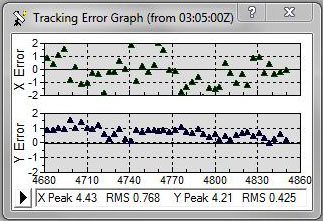 |
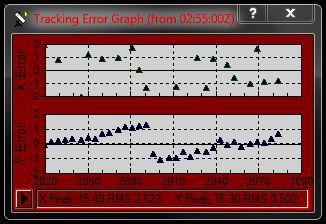 |
Takahashi EM-11: MaxIm DL
Tracking Error Graph from the Orion Starshoot for Takahashi
EM-11 with TSA-102 and Vixen 70s guidescope with 2x Barlow
lens to bring guidescope FL to 840mm to match with the 816mm
FL of the TSA-102. X error is off the Dec axis. Y error is off the RA
axis. The mount was polar aligned using the polar scope and then
microadjusting it by drift alignment. This is the best track that I
got after balancing the telescope on the mount and adjusting MaxIm DL
settings.
|
Takahashi
EM-11: MaxIm DL Tracking Error Graph from the Orion Starshoot for
Takahashi EM-11 with TSA-102 and Vixen 70s guidescope
with 2x Barlow lens to bring guidescope FL to 840mm . This is
typical variation in dec and RA tracking that occurred within 10-15
minutes of the start of an autoguiding session with the TSA-102 and
and guidescope system at 840 mm.
|
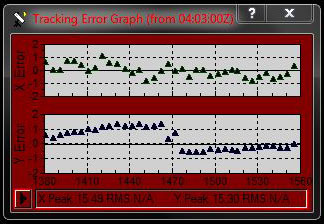 |
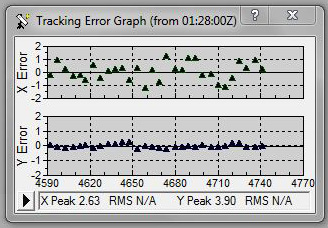 |
Takahashi
EM-11: MaxIm DL Tracking Error Graph from the Orion Starshoot for
Takahashi EM-11 with TSA-102 and Vixen 70s guidescope
to bring guidescope FL to 420mm . This is typical variation in
dec and RA tracking that occurs within 10-15 minutes of starting an
autoguiding session with the TSA-102 and a guidescope system at 420
mm.
|
Compared
tracking error with a Losmandy GM-8. MaxIm DL Tracking Error Graph
from the Orion Starshoot for a Losmandy GM-8 with
TSA-102 and Vixen 70s guidescope with 2x Barlow lens to bring
guidescope FL to 840mm to match with the 816mm TSA-102. The
Losmandy GM-8 is rated to carry a 30 lb. telescope system. X error is
off the Dec axis. Y error is off the RA axis. The mount was polar
aligned by drift alignment. This is the best track I got after
balancing the telescope on the mount and adjusting MaximDL settings.
The GM-8 is an incredibly capable mount and tracked accurately for 20
to 30 minutes as tested. However, the GM-8 with tripod legs weighs 8
more lbs. than a comparable EM-11 and doesn't easily break down into
as small a package that is as easily airline transportable. |
 |
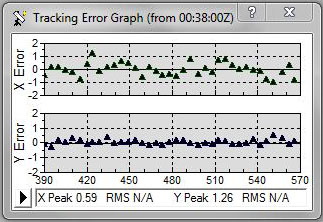 |
Light
load camera system and guidescope onTakahashi EM-11: Digital
camera and lens mounted with Vixen 70s guidescope and Orion Starshoot
autoguider on Losmandy DUP plate via G-11 SPT dovetail. Total weight
is 15 lbs.
|
MaxIm DL
Tracking Error Graph from the Orion Starshoot autoguider with the Takahashi
EM-11 with light weight digital camera and lens with
guidescope FL at 420mm.
Tracking was accurate and stable
over the 25 minutes tested with this 15 lb system on the EM-11. |
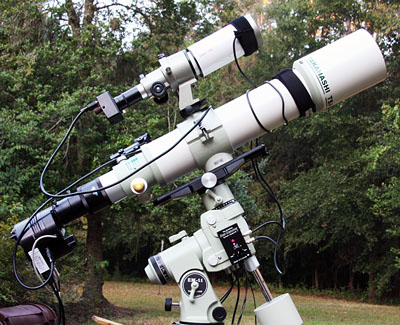 |
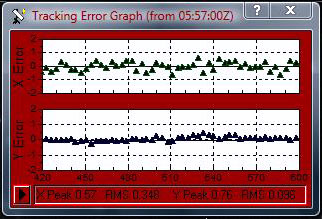 |
Takahashi
EM-11, TSA-102, Vixen 70s, SBIG ST-10XME with remote guiding head:
Tests were run with the guiding remote guiding head on the Vixen
70s at 420mm as well as the with the internal tracking chip through
the TSA-102 at 816mm.
|
MaxIm DL
Tracking Error Graph from the SBIG ST-10XME remote guiding head
through the Vixen guidescope at 420mm. Tracking was stable for
10-15 minutes, but then became as irregular as with the Starshoot
autoguider.
|
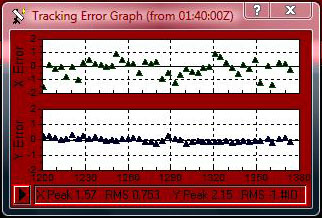 |
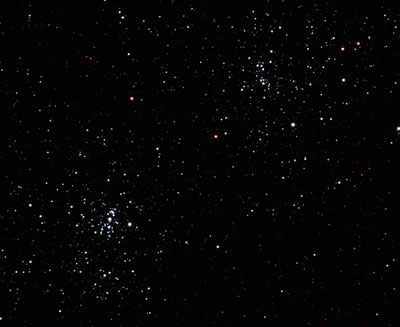 |
MaxIm DL
Tracking Error Graph from the SBIG ST-10XME internal chip through the
TSA-102 at 816mm. While tracking was accurate for 15 to 20
minutes, erratic tracking similar to that with the Starshoot
autoguider developed after that time.
|
Double cluster test.
EOS-40D / TSA-102 / TOA-35 flattener mounted on EM-11 guided by Orion
Starshoot autoguider through Vixen 70s guidescope (420mm). Stack of 4, 2
minute exposures. The telescope was focused with a Bahtinov focusing
mask using the 40D's live view function immediately prior to taking the
astrophotos. The TSA-102 with TOA-35 flattener produces slight color
aberration (see red ring around yellow stars). Otherwise, performance
was very good. |
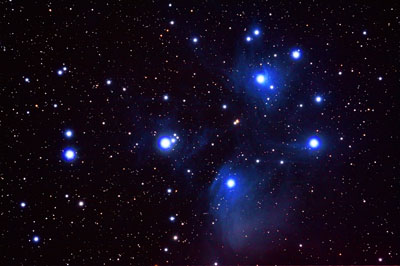 |
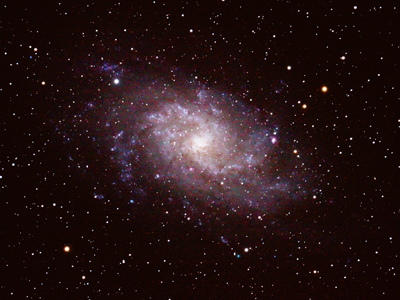 |
M45
test. Stack of 4, 5 minute exposures with EOS-40D / TSA-102 / TOA-35
flattener mounted on EM-11 guided by Orion Starshoot autoguider
through Vixen 70s guidescope (420mm). RAW images processed with DPP.
Tifs were stacked in Registar and processed with PhotoShop CS4. Only
the first 4 of 10 exposures in the series had round stars.
|
M33
test. Stack of 5, 5 minute exposures with EOS-40D / TSA-102 / TOA-35
flattener mounted on EM-11 guided by Orion Starshoot autoguider
through Vixen 70s guidescope (420mm). The first 5 of 17 exposures had
round stars. |
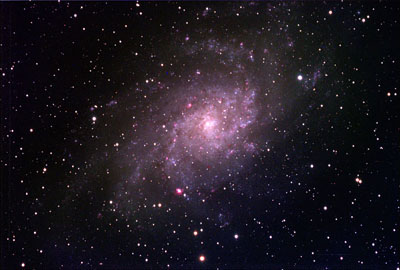 |
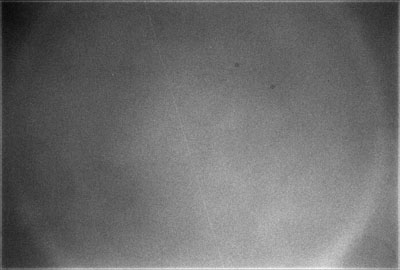 |
M33
test. Stack of 2, 5 minute exposures RGB and 10, 5 minute luminance
exposures. ST-10XME camera and autoguider with TSA-102 and TOA-35
flattener on EM-11 with Vixen 70s guidescope. The image is a mixture
of exposures run with internal and external guider operating at 840mm
and 420mm, respectively. Generally, only the first few astrophotos in
the series were good (e.g., had round star images associated with good
tracking). After 15 to 25 minutes of tracking, tracking accuracy
irregularity developed leading to ovoid-shaped star images.
The
TSA-102 and TOA-35 yield uneven illumination fields. Flats are
essential to image processing. |
Flat
field shot at dawn: TSA-102, TOA-35 flattener, SBIG ST-10XME with red
filter.
Line through field is a bright star trail producing by
running the mount at high speed while exposing the flat for 5 second. |
